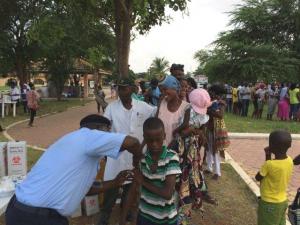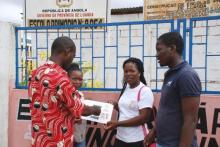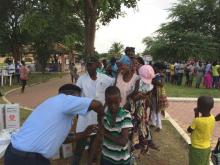Angola immunizes 6.7 million people against yellow fever
WHO experts remain at the frontline
Luanda, 9 March 2016 - Angolan health authorities and national and international partners continue making tireless efforts to immunize 6.7 million people in Luanda Province and to stop the yellow fever outbreak the country has been facing since December 2015.
WHO is supporting the procurement of 7.4 million doses of vaccine that will allow the vaccination of the entire population of Luanda above the age of 6 months.
A National Response Strategy is being implemented to break the Yellow fever transmission chain. The Strategy includes setting-up of advanced vaccination teams composed of an average of 400 health professionals per municipality. These teams are reinforced by 500 vaccinators from the National Army (FAA) Health Services, 120 from the National Police and 50 volunteers from the Angolan Red Cross (CVA). WHO experts have played a crucial role in training those national teams as well as in the overall organization of the mass vaccination campaign. The target is to vaccinate more than 80% of the population of the Luanda Province by the 18 March 2016, which is estimated at 6.7 million inhabitants. This is the first time ever that Angola has held such massive vaccination campaign.
The yellow fever vaccine was introduced in the vaccination calendar of the Expanded Programme of Immunization (EPI) in the year 1980. However, WHO Experts stress that the yellow fever vaccination coverage from the EPI programme is below the recommended 80% coverage rate. This low vaccination coverage rate in Angola may explain why the victims of the current yellow fever outbreak are mainly individuals above 15 years old which have not been reached and covered by the routine vaccination calendar.
A serious constraint that national authorities are facing is to ensure safety in high performing vaccination posts that attend thousands of people per day. The control and organization of the population to get the vaccine in an organized manner is a difficult task. It is also difficult to ensure an smooth logistic process including the timely supply of vaccines. “The number of police officers on the ground coupled with insufficient operational and logistics resources is insufficient to maintain order in overcrowded vaccination posts, " a vaccinator noted.
Up to date, The World Health Organization provided a financial support to the national authorities in the amount of USD 289,383.65 from the African Public Health Emergency Fund (APHEF). WHO has also made an additional contribution of a half a million dollars (US$ 500,000) from the Contingency Fund for Emergencies (CFE) to support operational costs related to the yellow fever vaccination campaign. WHO has also supported the development of an emergency response plan that makes provision for the mobilization from the United Nations Office for the Coordination of Humanitarian Affairs (UNOCHA) of additional US$ 7,197,824 that includes 50% of the costs of the vaccines for the province of Luanda.
Miranda Lussoki, a social mobilization officer from the Viana Municipal Health Department who has been trained by WHO and UNICEF experts to intensify the social mobilization and community engagement in high risk areas, emphasized that everyone wants to get vaccinated and explains the massif demand: «There is panic among the population who fear losing their lives if they are not vaccinated against the yellow fever. To address this problem we need more sensitization materials and a higher number of social mobilization volunteers», he stressed.
In recent days, the impact of the vaccination campaign start to be observed as a result of major epidemic control strategies alongside other preventive measures such as vector control and protection against mosquito bites. In the last eight days, the country has shown a marked reduction of suspected cases from 157 to 79. Likewise, the number of deaths has also decreased by 63%.
As of today, available data has shown that there were 65 confirmed cases, 813 suspected cases, and 138 deaths of yellow fever in Angola. The epicenter of the epidemic continues to be the Viana Municipality, in Luanda. There is no evidence of local transmission in other areas. However, the provinces of Benguela, Bié, Cabinda, Huambo, Huila and Kwanza Sul, have confirmed reported cases, all of them have epidemiological links with Luanda.
______________________________________
For further information, please contact:
Dr Jean-Marie Kipela, Tel: +244 941280588; Email: kipelam [at] who.int (kipelam[at]who[dot]int)
Dr François Nguessan, Tel: +244930443862; Email: nguessanf [at] who.int (nguessanf[at]who[dot]int)






